When I started looking for a place down in Florida, I wasn’t expecting to find much beyond the usual stucco sameness and kitchens dipped in a decade-old Home Depot clearance sale. You know the look—stainless steel everything, gray subway tile, and matte finishes as far as the eye can glaze over. But sometimes the audio gods smile on you. Imagine my luck stumbling onto a modern ranch along the Treasure Coast with a finished kitchen that didn’t scream contractor special. No renovations needed. Instead, I found myself standing in front of a full set of GE Café appliances clad in Matte White with Brushed Copper hardware. It was sleek, it was slightly rebellious, and it was definitely not the Bosch black-and-walnut vibe everyone assumes I live in.
Turns out, I’m allowed a little color.
If you’ve been following my recent freefall—yep, the one that threw me into some hot water, 13 weeks of inpatient therapy, and a brutally honest audit of my life—you know some tough calls had to be made. Living in two states, juggling three homes (including that cabin I rambled about in the first Cabin Audiophiler), and somehow ending up with way less space. Sounds weird, right? Three homes but less room to breathe. Welcome to the chaos I cooked up for myself.
As a consequence, I’m now sentenced to chewing stale biltong and sipping Rooibos tea for eternity. Which, let’s be honest, isn’t the worst punishment ever.
But here’s the thing—I’m starting fresh. Only this time, I’m bringing some color back into the picture and scaling down to smaller, smarter systems. Because sometimes less really is more, and sometimes you just need to shake things up.
Back in May, I got a little carried away (somewhere between poetic and sandwich-drunk, thanks to Mike’s Amazing Mayo spiked with hot honey and a hit of Tapatío) talking about how high-end audio gear was finally getting the memo about color. And not just any color—good color. Real personality. Tivoli Audio, to their credit, seemed to get it better than most. While others were still stuck in their fifty shades of meh, Tivoli leaned into the retro-modern thing with actual confidence—and it showed.
Which brings me to the Tivoli Audio SongBook MAX—because sometimes, design and personality do meet in the middle. And when they do, it looks (and sounds) like this.
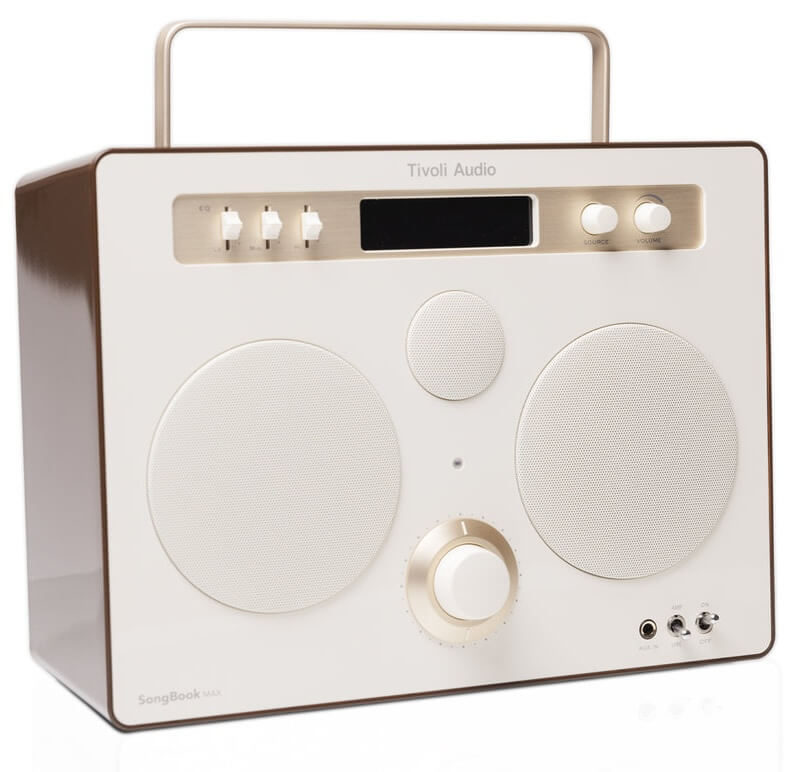
Tivoli Audio SongBook MAX: The Speaker That Leaves the Ruark R1 Shaking in the Corner
Let’s talk features—because the Tivoli Audio SongBook MAX isn’t just another pretty mid-century face trying to coast on nostalgia. This beast packs built-in Bluetooth 5.3 (SBC only) streaming, so you can ditch the wires but keep the jams flowing. Inside, you’ve got a three-driver setup: a ¾-inch tweeter for the highs, a 4-inch midrange, and a 4-inch subwoofer to shake the room like Brad Marchand shaking Leafs fans’ dreams—twice now, with Stanley Cups for both the Bruins and the Panthers. Honestly, the Leafs have been collecting heartbreak for 58 years—Marchand’s just the latest expert at the craft.
Frequency response spans a respectable 40 to 20,000 Hz, and the system pumps out a solid 50 watts of rated power.
For those who still cling to the radio dial, there’s a built-in FM/DAB tuner with five presets, complete with a tactile analog tuner knob and a handy scan button. Sound shaping is analog too, with EQ sliders that let you fine-tune your tone without fumbling through digital menus. The digital display keeps you informed without stealing the retro vibe.
It’s no lightweight, tipping the scales at 16 pounds, but it comes with a built-in handle for easy lugging—because this isn’t a bookshelf puppy, it’s a proper portable powerhouse.
The rechargeable battery keeps the music going for up to 10 hours, and charging is speedy via USB-C (cable included, but heads up: no charger in the box—Tivoli assumes you’ve got at least ten of those things lying around, or buried in that grimy cup holder in your SUV).
It supports USB PD Fast Charging, but you’ll want a proper 15V/1.5A charger to hit peak speeds.
The MAX always runs off its battery—even when plugged in—so don’t expect a magical “AC mode” boost. Leave it plugged in too long and you might wear the battery prematurely. A red LED tells you it’s time to juice up, and once that light kicks on, you’ve got about 30 to 60 minutes left before it powers down. Plan accordingly or embrace the silence.
Plus, it’s got an IPX4 water resistance rating, so a little splash or spill won’t ruin the party—but definitely not a beach speaker—as tempting as it was living only blocks away in both New Jersey and Florida.
Got instruments? Flip the front panel metal switch to “Amp” and plug in your guitar, bass, or turntable without needing a phono preamp. Switch back to “Line” for keyboards, turntables with built-in preamps, or other audio toys (you’ll need an RCA-to-1/4″ adapter for those). Dimensions clock in at 15 by 11 by 7.5 inches—compact enough to fit in your space but big enough to command attention.
Pro Tip: There’s no built-in phono preamp, so if you’re thinking of plugging in a turntable, make sure it has one—or use an external unit. Without proper RIAA equalization, your records are going to sound thin, flat, and about as exciting as a rain delay at Citi Field.
All in all, this isn’t your grandma’s Bluetooth speaker. It’s built for those who want vintage style and modern muscle without the Leafs-level disappointment.
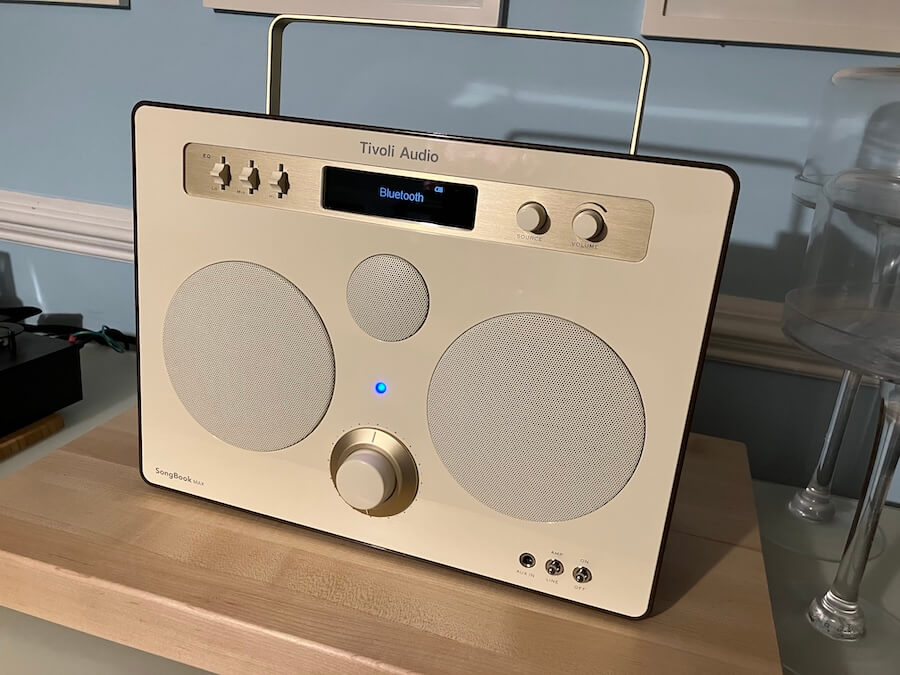
My review sample came in the Cream/Brown finish—there’s also a green option if you’re feeling adventurous. Tivoli just dropped the SongBook MAX (New.ordinary Edition), which cranks the cream vibe way up but with some serious upgrades: real leather wrap, chrome hardware, and a finish so rich it makes most “mid-century modern” wannabes look like those cheap plastic toys you find at Design Within Reach—and not the good kind. Most of these are already gone, naturally. Tivoli Audio recently rolled out fresh new color combos for the SongBook and SongBook MAX—Black/Black and Blue/Gold—that really pop.
Take it out of the fancy packaging, and the design still hits hard. It’s not just some pretty face; this thing demands attention without trying too hard—unlike Brad Marchand, who’s been busy reminding Leafs fans what losing looks like for the 58th year running—couldn’t resist. Sharp, stylish, and unapologetically confident—just how a good speaker should be.
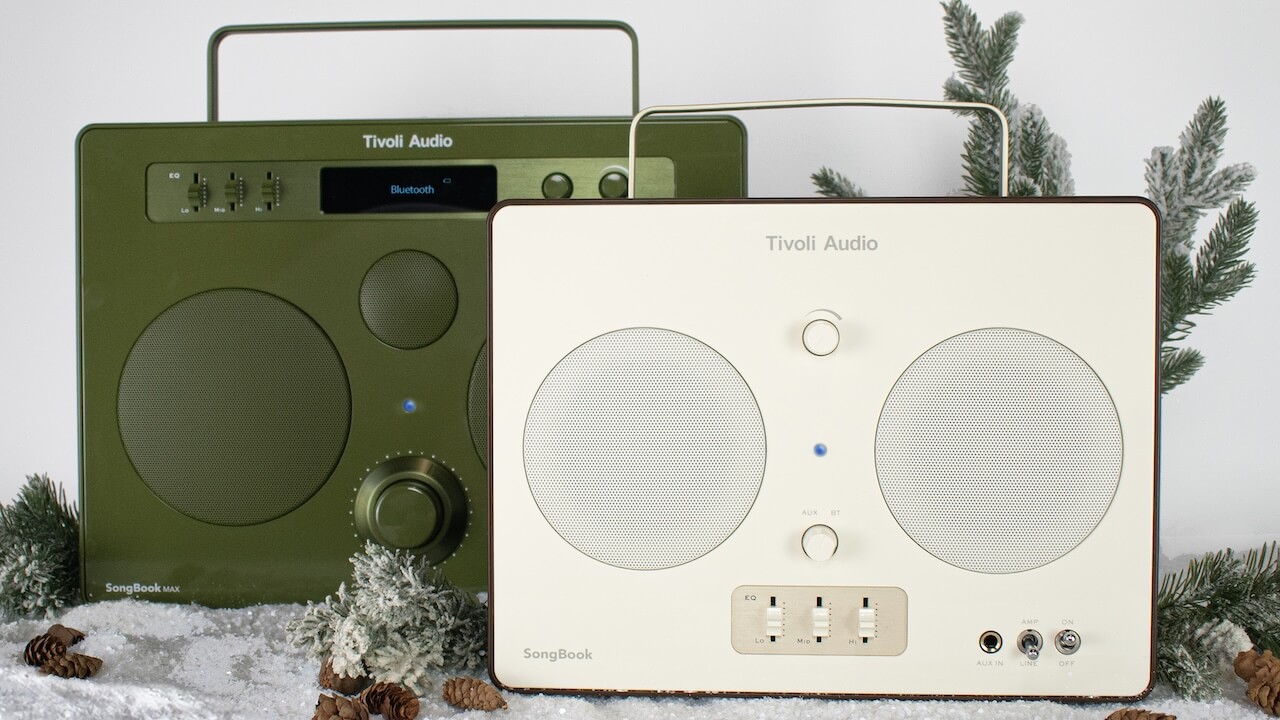
What I appreciate most about the SongBook MAX is that it feels like it was built for the long haul—like 28 Years Later long haul, assuming civilization survives and we’re still able to scavenge a USB-C charger from the ruins of a Walgreens. The construction is seriously solid, with a reassuring heft that makes every part—from the analog knobs to the oversized handle—feel like it was designed by someone who actually cares about longevity.
The fit and finish? Just about right for the $599 asking price, with enough polish to impress but enough toughness to take a few hits. This isn’t some disposable Bluetooth toy; it’s a proper object. Heavy, satisfying, and stubbornly analog in all the best ways.
As much as I dig the overall design and tank-like build, there are a few quirks that don’t quite hit the mark. The display, for one, is bright and easy to read—great in FM/DAB mode where you actually see song titles scroll across. But switch to Bluetooth? Nothing. Just silence on the screen like it suddenly forgot how to talk. The tuning dial, while charmingly analog, could stand to be a bit smoother and more precise. Trying to lock in a clean FM signal here on the Shore—or over the bridge in Vero—had me feeling like I was cracking a safe in the dark. When I did lock in a signal, it didn’t drift and the reception was quite good.
The source selector also feels a little too coarse, with no satisfying “click” when jumping between inputs. And then there’s the volume. With my iPhone cranked to max, it took barely a nudge on the dial to reach “terrify the dog” territory. Some better alignment between source volume and speaker gain wouldn’t hurt. Small gripes, but noticeable.
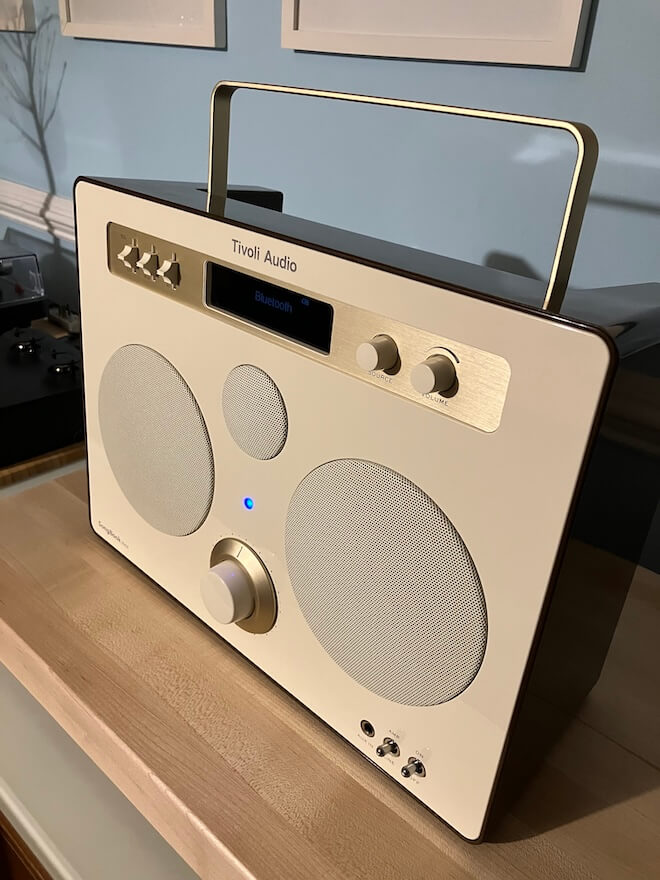
Listening: Because You’re Not Here to Waste Away in Margaritaville
Back in 2001, my soon-to-be-ex-wife dragged me—and three of her equally pale friends—to a Jimmy Buffett “concert” at Alpine Valley, Wisconsin. That night cured me for life. Between the parrot hats, the watered-down margaritas, and the endless chorus of boomers shouting “Fins up!”—I knew I’d found my personal version of hell. And don’t get me started on those godawful restaurants that haunt every Caribbean cruise port like a tacky hangover.
So if you think that vibe followed me down to Florida’s Treasure Coast, think again. No cheeseburgers in paradise here. I sincerely hope my new neighbors enjoy a steady diet of Kraftwerk, Talking Heads, Eric Dolphy, Ella Fitzgerald, the ORB, Amy Winehouse, Johnny Cash, and Shostakovich.
Because the only parrothead on this block is stuffed and mounted—right next to my collection of John Prine, Los Lobos, and Lee Morgan records, where the vibe runs deep and the lyrics don’t come with a side of frozen shrimp cocktail.
The Tivoli doesn’t offer Spotify Connect, TIDAL Connect, or Qobuz Connect—and honestly, that’s fine. Nobody’s going to throw a mojito if those show up in a firmware update someday, but for now, Bluetooth gets the job done. What stood out immediately was the sheer volume the SongBook MAX can push. We’re not talking dainty dinner party tunes here—this thing moves air.
I set it up on the back edge of my brick pool wall (don’t worry, it was never closer than a foot to the edge—nobody’s recreating Scarface on my watch), cranked it gradually, and walked down the 50-foot stretch of driveway to the street. Still loud and clear. Just don’t stand in the middle of the road trying to taste test the soundstage—this isn’t Miami Vice, and I’m not Tubbs with a death wish.
Back in Jersey, I plopped the SongBook MAX on a $400 IsoAcoustics isolation platform—because why not give a portable speaker the audiophile spa treatment? Bass tightened up noticeably, but even with the platform doing its thing, I could still feel the low-end rumble pulsing through the sides of the credenza like a teenager hiding subwoofers from his parents.
Anything past 8 or 10 on the dial was more than enough to fill my 16′ x 13′ x 9′ dining room with serious energy. Walking into the kitchen, the impact was still there—less wall-shaking, more head-nodding, but very much alive.
The final test? Out on my 20′ x 10′ deck, elevated above a 100′ x 75′ backyard facing east toward the Atlantic. I cranked it to 13 and let it rip: Metallica, The ORB, and yes, Miley Cyrus. From corner to corner, lawn to fence, every lyric landed like a punch. Even the squirrels were nodding in time.
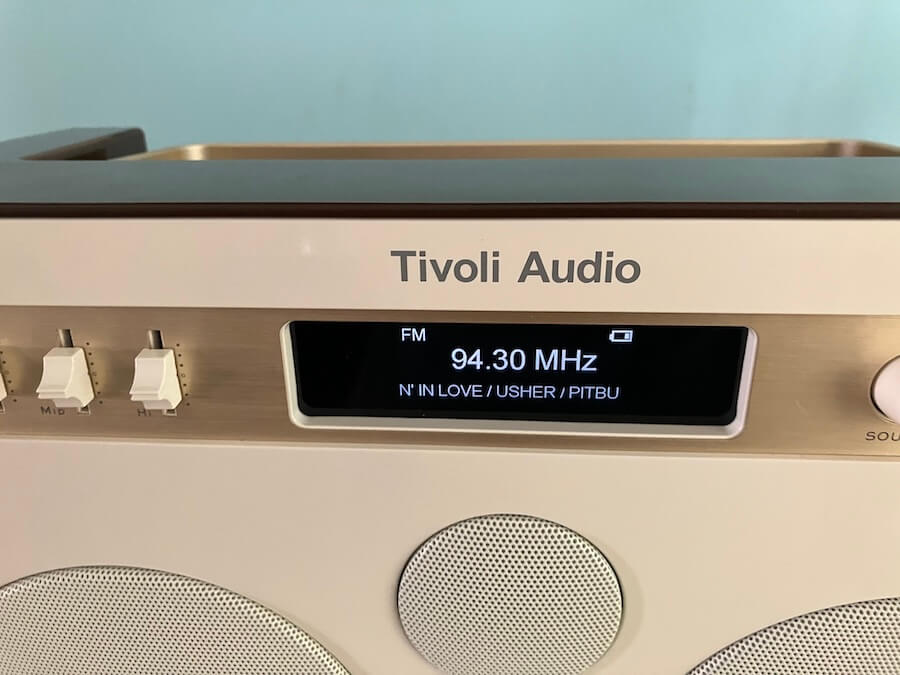
From Ella and Louis to Lana and Kraftwerk: Genre-Jumping Without Missing a Beat
I was initially tempted to say the SongBook MAX leans into that classic ‘V-shaped’ sound—big bass, a bit of sparkle up top—but after a lot more listening, that felt like a stretch. The midrange is definitely a touch reserved compared to the rest of the spectrum. Vocals sit slightly behind the instruments in the soundstage, giving things a bit of a laid-back feel.
That said, it’s not the kind of tonal dip that’ll have you diving into the EQ settings out of frustration. And if you do decide to tweak it, the EQ actually responds like it should—which, sadly, is not something you can always count on at this price point.
And those changes? They were pretty subtle. We’re talking maybe a decibel up or down—just enough to fine-tune without breaking what already works. Sliding the bass slider to -5 dB sucked the life out of the low end, so I mostly left it right at the default.
The midrange, on the other hand, sometimes needed a gentle nudge, especially on tracks featuring Ella, Amy, or Lana Del Rey. Give that range a slight lift and suddenly the vocals stepped forward with more presence—you could actually hear the difference without second-guessing yourself.
Amy Winehouse’s death still leaves a bad taste in my mouth. Gone way too soon—and yeah, largely because of her own choices (a familiar path, though my demons weren’t chemical). Still, the waste of that kind of once-in-a-generation talent stings. That duet with Tony Bennett? Watch his face. The man lit up. Here’s this tiny, tattoo-covered, beehive-wearing British Jew who looked like she hadn’t eaten in a week, and out comes this voice—rich, soulful, unmistakably real.
“Valerie” from her BBC session has always been one of my go-to torture tests for treble control. That etched top end can shred a brittle tweeter and make you lunge for the volume button before it goes full meltdown—kind of like the singer herself. But the SongBook MAX handled it with a surprising amount of grace. That gentle dip in the upper mids and lower treble tamed the glare without sucking the soul out of her performance. Amy still sounded like Amy.
But it also revealed something else: the Tivoli doesn’t sound thin, but there’s a bit of dryness to the presentation. Notes stop clean—sometimes a little too clean. The decay is quick, almost abrupt, like it’s in a hurry to get to the next beat. It’s not sterile, but if you’re expecting tube-like bloom and trailing reverb, this ain’t it. Then again, neither was she.
Ella’s duet with Louis brought much of the same vibe. That classic swing—the back-and-forth, the playful phrasing, that unmistakable raspy charm from Louis—sounded lively and propulsive. The SongBook MAX didn’t miss a beat; rhythmically, it’s rock solid. Never once did it feel like the Tivoli was playing catch-up with the music. Timing? Nailed. Pacing? Spot on.
But here’s the rub: the warmth and texture that make those recordings timeless—the way Louis’s trumpet flutters or Ella’s voice glides like silk on a hardwood floor—felt a little underfed. Like the speaker could use an extra bowl of matzo ball soup on a cold Shabbos. (Donny, you’re out of your element.) The detail’s all there, but the humanity, the depth, that last bit of soul you can feel in your chest—it’s just a touch restrained.
Still, it’s an enjoyable listen. You won’t find yourself reaching to turn it off, just maybe leaning in a bit, hoping it’ll dig a little deeper next time.
But now we have to talk about Lana. My 12-year-old dumped Melanie Martinez for Lana Del Rey faster than you can say “TikTok drama.” Why? A poorly timed anti-Israel rant on social media. Pro tip: never mess with a kid who attends Yeshiva, is besties with the Syrians on the Shore, and can walk you through the proper serving order of every Sephardic dish from Aleppo or Deal on a Shabbat morning. The kid knows her priorities—and apparently, her moody alt-pop queens.
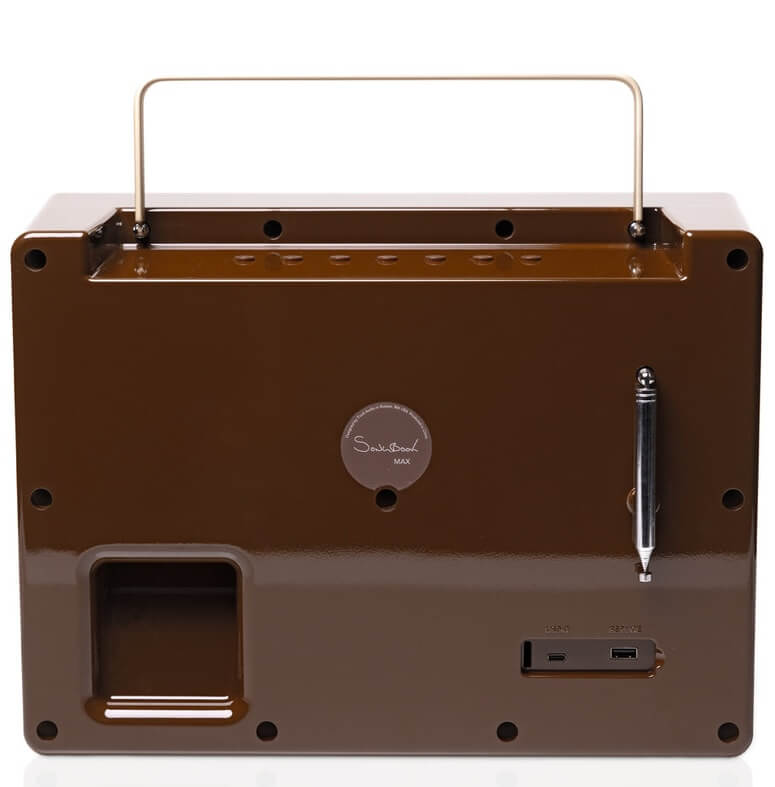
The SongBook MAX surprised me here. It has this weirdly brilliant ability to make tracks that are sonically mediocre sound—dare I say it—elevated. “Video Games” and “Chemtrails Over The Country Club” aren’t exactly paragons of hi-res production, but through the Tivoli, they gained a haunting shimmer. That Lana haze, the reverb-drenched melancholy, the slow-burn drama—it bloomed in the kitchen in a way that felt just right. The echo off the backsplash, the hum of the fridge—it all somehow blended into the vibe.
Look, Lana can’t match Amy’s soul, grit, or vocal range—and she’s not trying to. But she doesn’t need to. That swirling, atmospheric aesthetic? Pretty, pretty good. (Cue Larry David shrug.) And through the SongBook MAX, that “sad girl Americana” felt just rich enough to make me stop slicing cucumbers and actually listen.
Compared to the Bluesound Pulse Mini 2i, the Tivoli SongBook MAX is more vibey and less thick. The Bluesound wins on ecosystem integration (Roon, BluOS, better app control, Wi-Fi streaming) and still punches harder when it comes to raw DSP and bass control—but it’s also heavier, not portable in the same way, and definitely not as stylish unless your kitchen is decorated in “gray box with buttons.” The Tivoli? It screams personality, goes just as loud, and feels more tactile with its analog controls—even if it’s missing Spotify Connect and network smarts.
Next to the DALI KATCH G2, the SongBook MAX trades finesse for brute strength. The KATCH is smoother, more detailed in the mids, and easier to toss in a bag. But it doesn’t have FM, it can’t double as a mini amp, and it sure doesn’t have EQ sliders and a physical handle that looks like it came off a vintage military radio. At $750, the DALI feels like a luxury accessory. The Tivoli at $599? Feels like a tool. A very loud, very fun, very cream and brown tool.
The Bottom Line
The Tivoli Audio SongBook MAX isn’t trying to be everything for everyone—and that’s exactly why it works. It’s unapologetically retro in aesthetic, surprisingly muscular in performance, and built like a product you pass down to your grandkids, assuming you can find a USB-C charger in the wasteland of the not-so-distant future.
Sonically? It’s a bit of a balancing act, but one that mostly sticks the landing. There’s legit bass, serious presence, and a sense of scale that borders on the ridiculous for a portable—borderline obnoxious, in the best way possible. The midrange steps back a bit, so if you’re chasing that warm, nuanced intimacy found in higher-end gear north of $500, you might come away wanting.
Still, the onboard EQ isn’t just for show—it’s responsive, and the subtle dip in the upper mids does a nice job keeping sharper vocals in check. Amy and Lana made it through “Valerie” and Chemtrails Over the Country Club without detonating the kitchen backsplash. That’s a win.
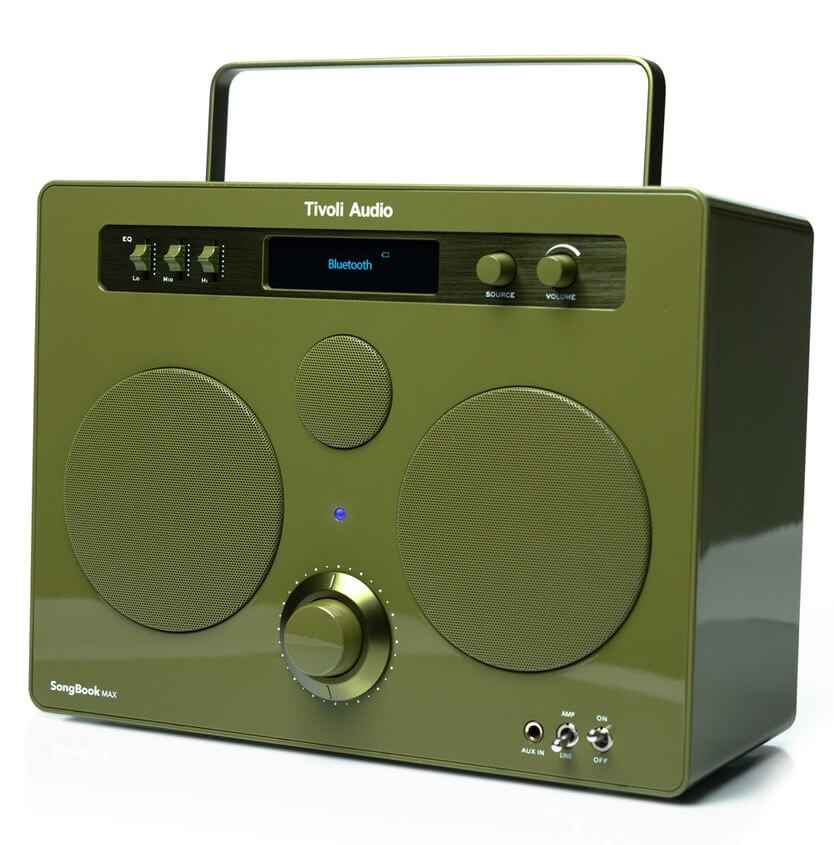
Design quirks? Sure. The tuning knob is more “close enough” than precise, the volume ramp is aggressive when paired with a phone, and the lack of song info over Bluetooth feels like an oversight.
Also, no built-in streaming support like Spotify Connect or TIDAL Connect—which is a bummer in 2025 but not a dealbreaker. Maybe Tivoli thinks you still enjoy using your phone. Or maybe they assume you’re too old to care. Either way, it works well enough that you probably won’t miss it.
But with everything else going for it—tuning, power, materials, portability, vibe—it still delivers way more than most Bluetooth speakers in its price range dare to attempt.
This is a speaker for someone who wants serious output, eye-catching style, and rock-solid construction that doesn’t feel like a plastic Bluetooth turd from the clearance aisle at Target. Tivoli didn’t reinvent the wheel, but they damn well made sure it could crush a few AirPods in the process.
So is it worth the money? If you’re into gear that feels built to last, sounds way bigger than it looks, and doesn’t take itself too seriously while still getting the job done—yeah, the Tivoli Audio SongBook MAX earns its keep. This is the kind of loudspeaker that slowly works its way into your life, day by day, playlist by playlist, until you realize it’s not going anywhere.
I’m listening to it right now, staring out my kitchen window at my wildly enthusiastic Cuban neighbors screaming at each other in the driveway (possibly about flan, definitely not in whispers), sipping Rooibos and working through a Publix bagel loaded with whitefish salad, tomato, capers, and just the right amount of regret. And I’m thinking, “Do these people want me to blast 2112 for the rest of the afternoon?” Because I can. And thanks to the SongBook MAX, I just might.
Pros:
- Big, Bold Sound: Plays loud with real authority—impressive bass and scale for a portable.
- Sturdy as Hell: Heavy, solid construction that feels built for the long haul (or a zombie apocalypse).
- Design That Pops: Mid-century flair meets modern function—looks fantastic in the right space.
- Functional EQ: Onboard EQ sliders actually work and offer real control without needing an app.
- Versatile Inputs: ¼” aux with switchable preamp means you can plug in guitars, turntables, or keyboards.
- Bluetooth Streaming: Reliable wireless connection with strong signal stability.
- Water Resistant: IPX4 rating makes it poolside-worthy (though maybe not hurricane-proof).
- Battery Life: 10 hours on a full charge with fast USB-C top-up.
Cons:
- Midrange Recessed: Vocals can sound a bit pulled back—don’t expect tube amp warmth.
- No Connect Support: No Spotify Connect, TIDAL Connect, or Qobuz Connect (yet).
- Display Quirks: Shows track info in FM mode but not over Bluetooth
- Tuning Dial: A bit imprecise—can take some fiddling to lock in clean FM reception.
- Volume Ramp: Loud gets loud fast—volume alignment with your phone could use a tweak.
- No USB-C Charger Included: Tivoli assumes you have 14 in your glovebox already (they’re not wrong).
- Price Creep: At $599, it faces some competition from Ruark, DALI, and Bluesound.














